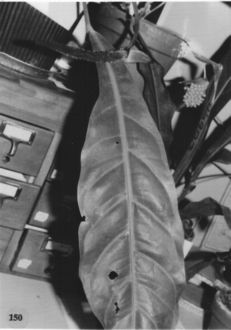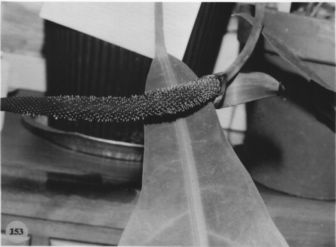





Selbyana 5 (3-4): 328. 1981. TYPE: Panama. Bocas del Toro: Station Milla 7.5 on Changuinola-Al-mirante Railroad, less than 100 m above sea level, along slender ridge to WW II communications facility, ca. 2 km NW of ruins of U.S. Army military barracks, Croat 38094 (MO-2388335, holotype; CAS, F, K, MO, PMA, SEL, US; isotypes; Live at MO).
LEAVES erect to spreading; petioles 12-31 cm long, 4-10 mm diam., ± quadrangular, flat to broadly and sharply sulcate, usually prominently 3-ribbed abaxially; geniculum 1-2.5 cm long; blades oblong-oblanccolate to oblong-elliptic, coriaceous, acuminate at apex, obtuse to acute or attenuate at base, 27-74 cm long, 7.5-40 cm wide, broadest al or above the middle; upper surface matte to semiglossy, lower surface glossy to semiglossy; midrib acutely raised above and below, diminishing at apex above; primary lateral veins (6)11-14 per side, departing midrib al 45° angle, raised in valleys above, raised below, arcuate-ascending, loop-connected in upper half; interprimary veins flat or prominulous above, prominulous below; secondary veins flat above and below; collective vein arising from one of the primary lateral veins near the middle, 4-8(13) mm from the margin, sunken above, raised below.
INFLORESCENCE erect; peduncles 3-38 cm long, 0.8-2 cm diam., purplish or green, subterete, equal to or as long as petioles; spathe medium thick, purple to purplish with green mottling especially near base at center or green mottled with purple (B & K Red-purple 2/ 5) al anthesis, oblong to narrowly ovate, 4.5-17.5 cm long, 1.5-4 cm wide, broadest just above the base, cuspidate at apex, obtuse to rounded at base; spadix violet-purple (B & K Purple 2/ 7.5), (4)5-22 cm long, 1-2.5 cm diam. at base, 4-8 mm diam. at apex; flowers rhombic to weakly 4-lobed, 2-2.3 mm long, 2.5-3 mm wide, the sides gradually tojaggedly sigmoid; ca. 14 flowers visible in the principal spiral, ca. 7 flowers visible in the alternate spiral; tepals matte, with small scattered droplets, lateral tepals 1.4-1.6 mm wide, the inner margin flat against pistil; pistils slightly raised, purple becoming green and finally orange; stigma linear, ca. 5 mm long, with droplets for 4-10 days, drying with exserted papillae 4-6 days before first stamen emerges; stamens exserted ca. 1 mm, emerging in a slow progression from the base, the lowermost flowers with their full complement before the middle flowers have any stamens exserted, held in a tight, contiguous circle; filaments 0.2-1 mm long, flattened, transparent, tapered to anther, retracting to hold anther at edge of tepals; anthers ca. 0.7 mm in both directions; thecae ellipsoid, usually held closely parallel; pollen golden yellow (B & K Yellow 8/2.5), drying white.
INFRUCTESCENCE erect to spreading; the spathe drying, usually persisting; spadix 9-19 cm long, to 4 cm diam.; berries narrowly ovoid, acute at apex with a round, minute, mammilliform style, orange, red-orange to red (B & K Red 6/7.5), to 10 mm long; the me-socarp pasty, transparent; seeds 1 or 2, ca. 4 mm long and 2 mm wide, pale greenish-yellow. Figs. 150 and 153.
The species is endemic to Panama and occurs principally from near sea level to 200 m in Bocas del Toro Province in wetter pans of tropical moist forest and premontane wet forest. It is to be expected in Limón Province in Costa Rica. A population on Cerro Colorado, in tropical wet or premontane rain forest at 1,200 to 1,500 m appears to differ in no way from the populations at lower elevations except that it has thicker leaves and consistently terrestrial habit. The terrestrial habit is not unusual for populations at higher elevations where a greater accumulation of debris exists and where the steeper slopes provide belter drainage. The species should be expected al medium elevations as well.
Anthurium purpureospathum is distinguished by its rosulate habit, more or less oblanccolate leaf blades, almost quadrangular petioles often 3-ribbed abaxially, generally short peduncles, usually violet-purple reflexed spathe, usually short violet-purple spadix, early emergent pistils and long, sharply pointed, orange to red-orange berries.
The species is a member of section Pachyneurium, although the leaves sometimes have a collective vein arising from below the middle. It is closely related to no other known species.
 |
 |
Map of Mesoamerican specimens with coordinates
Panama Bocas del Toro: 175 m, 8.46N 82.16W, 25 June 1987, Thomas B.
Croat 66820 (MO).
Panama Bocas del Toro: Fortuna Dam Area, 310 m, 8.45N 82.10W, 9 March
1985, Croat & Grayum 60145 (B, MO).
Panama Bocas del Toro: Isla Colón, 0-120 m,, 16 May 1940, Wedel 125
(MO).
Panama Bocas del Toro: Isla Colón, 0-120 m,, 27 Aug. 1940, Wedel 569
(GH, MO).
Panama Bocas del Toro: Water Valley,, 11 Sept. 1940, Wedel 708 (MO).
Panama Bocas del Toro: Water Valley,, 14 Sept. 1940, Wedel 774 (GH,
MO).
Panama Bocas del Toro: Chiriquí Lagoon,, 20 Sept. 1941, Wedel 2721
(GH, MO).
Panama Bocas del Toro: Río Cricamola, 10-50 m,, 12-16 Aug. 1938,
Woodson et al. 1889 (MO, NY).
Panama Bocas del Toro: 300-500 m,, 13 Dec. 1979, António 3148 (MO).
Panama Bocas del Toro: 190-220 m,, 4 Aug. 1976, Thomas B. Croat 38180
(MO).
Panama Bocas del Toro: 30 m,, 27 July 1971, Croat & Porter 16416
(MO).
Panama Bocas del Toro: Río Guarumo,, 5-7 June 1967, Lewis et
al. 1985 (MO, NY).
Panama Bocas del Toro: Río Changuinola,, 19 Apr. 1969, Lazor
& Tyson 2661 (MO).
Panama Bocas del Toro: 100 m,, 3 Aug. 1976, Thomas B. Croat 38094 (B,
BM, CAS, C, CM, CR, DUKE, F, GH, IBE, K, LE, M, MISSA, MO, NY, P, PMA,
QCA, RSA, S, SEL, US, VEN, W).
Panama Bocas del Toro: 0-100 m,, 2 Apr 1977, D'Arcy 11207 (MO).
Panama Bocas del Toro: 30-200 m,, 4 Aug. 1976, Thomas B. Croat 38214
(MO, PMA).
Panama Bocas del Toro: 190-220 m,, 4 Aug. 1976, Thomas B. Croat 38179
(MO).
Panama Bocas del Toro: 120 m, 08.57N 08.56W, 29 March 1993, Thomas
B. Croat 74936 (MO).
Panama Bocas del Toro: Isla Bastimentos, 30-100 m,, 14 Feb 1989, Peterson
& Annable 6855 (US).
Panama Bocas del Toro: Fortuna Dam Area, 120 m, 8.55N 82.10W, 5 March
1986, Gordon McPherson 8572 (MO).
Panama Bocas del Toro: < 100 m, 09.21.40N 82.31.40W, 25 June 1994,
Thomas B. Croat & Guanghua Zhu 76432 .
Panama Chiriquí: Fortuna Dam Area, 80 m, 8.50N 82.10W, 9 March 1985,
Croat & Grayum 60090 (MO).
Panama Chiriquí: Cerro Colorado, 1430-1500 m,, 22 Aug. 1979, Thomas
B. Croat 48483 (MO).
Panama Chiriquí: Cerro Colorado, 1200-1500 m,, 12 March 1976, Thomas
B. Croat 33139 (CM, MO, NY).
Panama Chiriquí: Cerro Colorado, 1500 m,, 17-18 Feb. 1977, Folsom &
Collins 1835 (MO).
Panama Chiriquí: Cerro Colorado, 1200-1500 m,, 13 March 1976, Thomas
B. Croat 33257 (MO, PMA).
Panama San Blas: 350 m, 9.19N 78.55W, 6 Nov. 1984, Gred de Nevers 4207
(MO).